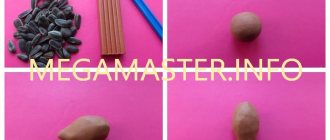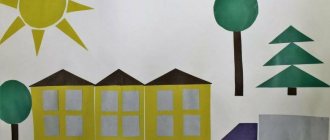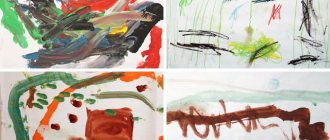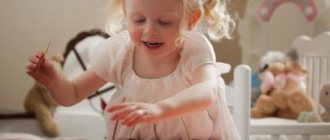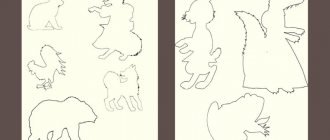On the topic: methodological developments, presentations and notes
direction of work: artistic and aesthetic.
Program content: teach children to combine different techniques of drawing paths with pencils and sculpting a kolobok in the shape of a ball, arouse interest in reviving the kolobok (beady eyes), teach how to roll a ball.
Goal: to develop the ability of children to sculpt rowan berries from plasticine, pinching small pieces from a large one and rolling them into small balls. Objectives: to teach children to connect berries into a bunch, to form int.
Summary of a modeling lesson on the topic: “Kolobok” in the first junior group.
Summary of a modeling lesson on the topic “Banana” in the first junior group.
Goal: - To form a holistic picture of the world during children’s productive activities. Tasks: - to develop the ability to work with plasticine. - To continue to introduce children to the concepts of “circle”, .
Goal: - To form a holistic picture of the world during children’s productive activities. Tasks: - to develop the ability to work with plasticine. - To continue to introduce children to the concepts of “circle”, .
material for teachers of younger groups. complies with Federal State Educational Standards
Progress of activities:
Bunny comes to visit the children.
Z. - Hello guys. Do you recognize me? Who am I? That's right, Bunny. I came to congratulate you on the beginning of the school year. I wanted to go visit the bear today and congratulate him, do you want to come with me?
V. - Guys, the forest is very far away. What can you use to go to the forest?
Z. – “My truck is a truck ,
Here is the cab, steering wheel and body,
She needs the body for cargo.
Bunny sitting in the back
He's looking at the wheels."
V. - Guys, look what happened to Zayka’s car ?
Z. - What should I do now?
V. – Don’t worry, Bunny, we have a workshop and the guys will be able to fix your car . Guys, can we help Bunny?
V. - Let's go to our workshop. Here are more cars , but not trucks, but cars . Now we can all go into the forest together, each in our own car .
V. - Guys, can we go to them? Why? What should be done? What wheel shape?
— To repair our cars , we need to warm our hands.
“We took plasticine into our hands
And we drove around a little
And then pressed lightly
And we weren’t at all tired.”
V. – Look carefully at how you and I will make wheels. First we will roll out a piece of plasticine. Then we apply it to the car and press lightly . What happened? These are the wheels you will attach to your car .
Pay attention to the sequence of work.
You can start working.
Independent work of children.
Offer to go to the forest in cars .
Physical education lesson: The song “ Machine ”
Children imitate the movements of driving a car .
Approaching the “den”
where the bear sleeps. They wake him up.
The game “At the Bear in the Forest”
.
Notes on sculpting "Sun" in the second junior group Notes on sculpting "Sun" in the 2nd junior group Purpose: to learn how to sculpt simple objects consisting of several parts of different shapes.
Summary of GCD for modeling in the second junior group “A friend for Mishka is a bunny” Summary of GCD for sculpting in the 2nd junior group “Friend for Mishka is a bunny” Objectives: To develop children’s interest in sculpting familiar objects consisting.
Abstract of the GCD for sculpting in the second junior group “Mouse-norushka” Program content: Educational objectives: Teach children to sculpt a mouse based on an egg-shaped shape. Show ways to create expressiveness.
Abstract of educational activities on object modeling in the second junior group “Cheerful Tumbler” Integration of educational areas: artistic and aesthetic development, social and communicative development; speech development, cognitive.
Notes on traffic rules in the second junior group “I’ll start my car” Materials and equipment: cars and trucks, a box of beans, figures of pedestrians (men from the LEGO set, model “On the streets.
Summary of the GCD lesson on sculpting “Make the Sun” in the second junior group Summary of GCD lesson on sculpting “Make the Sun” in the 2nd junior group Shaykhavova R. A. Goal: learn to sculpt simple objects consisting of several.
Summary of GCD for modeling in the second junior group “Pyramid” Purpose: To learn to compose an object from several parts of different sizes. Educational objectives: - to evoke a joyful mood and satisfaction in children. Notes on sculpting in the second junior group “This amazing underwater world!” Topic: “This amazing underwater world!” (plot modeling). Age group: second youngest. Type of activity: productive activity. Summary of GCD for modeling in the second junior group “Dymkovo Ducks” Objectives: 1. Continue to introduce children to the Dymkovo pattern 2. Develop the ability to make a traditional pattern 3. Cultivate a love for.
Summary of GCD for sculpting in the second junior group “Tank” GCD for sculpting in the second junior group. Topic: "Tank". Goal: to consolidate the ability to sculpt a tank from separate parts, to correctly convey the shape.
Liliya Stepanova
Summary of a lesson on modeling from plasticine in the second junior group “Truck”
Purpose of the lesson : Learning to create balls from plasticine by rolling it between your palms. Development of fine motor skills and imagination.
Preview:
Abstract of the GCD on artistic and aesthetic development in the 2nd junior group (modeling) "Let's make wheels for a car"
Integration of educational areas: cognitive development, physical development, artistic and aesthetic development, speech development, social and communicative development
Objectives: Learning to create balls from plasticine by rolling it between your palms, flattening it with your fingers. Development of fine motor skills and imagination.
Materials and equipment: Pictures of a car without wheels, a toy car, plasticine, napkins
Logic of educational activities: The teacher asks the children a riddle:
“Carries cargo back and forth,
Will never get tired.
There are also headlights, steering wheel, cabin,
After the children guess the riddle, the teacher takes the car out of the box. The children look at it, name its parts, name the color, and remember what they rode on it.
Then the teacher plays the game “Sparrows and the Car.” One child, representing a car, is given a steering wheel. Other children play the role of sparrows. The teacher says: “Sparrows! “Children sparrows begin to run around the room, chirping cheerfully. The teacher gives the command “Car!” the sparrows are running away,” The car is moving and buzzing: “Beep! "
Then the children sit down at the tables. The teacher hands out pictures to the children. He asks them to tell what is drawn on them. The children say that this is a car.
The teacher draws the children's attention to the fact that cars do not have wheels. He asks what is missing? Then he offers to help the car and make wheels for it.
The teacher shows how to make wheels, distributes handouts, and the children get to work. The teacher helps each child, comments on his own actions and the child’s actions. The teacher praises the children. The teacher conducts breathing exercises:
“Cars are flying along the highway -
Everyone is in a hurry and buzzing.
We pump up the tires
We breathe many times in a row"
(Children stand slightly slouched, head lowered, drop lower one time, arms hanging down - inhale, two times back to the starting position - exhale. The exercise is repeated 4 times)
The teacher once again thanks the children for their good work, now all the cars can hit the road.
Lesson notes for junior group 1, modeling. "Airplane"
MOLDING “PLANE”
GOAL: 1. Teach children to recognize winter and name its signs. Sculpt an airplane by rolling out sticks between your palms and connecting the parts.
2. Develop speech and imagination
3. Foster kindness, love and compassion for animals.
Medium: a painting depicting winter, books depicting Aibolit, a monkey, an airplane. Plasticine, oilcloth for modeling.
PROGRESS OF THE CLASS:
-Look at the picture, what time of year is it depicted? /Winter/
— How did you guess that it was winter? /A lot of snow on the roof, on the trees, on the ground/
— What’s the weather like outside in winter? /Cold, frosty, snowy/
-What do you and I wear so as not to freeze? / Hats, fur coats, mittens, felt boots / Good!
It’s here, it’s winter now, it’s cold, we dress warmly, but far, far away, beyond the forests, beyond the seas, there are countries where winter never happens! And there is no snow there either! One of these countries is Africa, it is always very, very hot there! In this country live small, cheerful... / showing monkeys, children add / monkeys! They live in trees and love bananas. They really wanted to look at our winter, at the snow, at the beautiful trees and fields. And the monkeys wrote a letter to Dr. Aibolit so that he would help them fly to visit us by plane. Look:
-Who is this? /Dr. Aibolit/
-Who is he treating? /animals/ The doctor helped the monkeys fly on these planes.
The teacher and the children look at the plane: look, what a wonderful plane, what does it have? /cabin, hull, tail, and wings/. Who's sitting in the cockpit? /pilot/
A lot of monkeys arrived, but trouble happened to them! They didn’t have warm clothes, they caught colds and got sick, and their planes also broke down. Doctor Aibolit and the monkey came to you for help! In order to transfer sick monkeys back to Africa, you need many planes, and we only have one. Will you help Doctor Aibolit and the monkeys, build airplanes?
—
Okay, then let's get to work.
We will have many colorful planes.
— What color will your plane be, Sonya?
- What about you, Dima? At Dasha's?
First, let's take a large lump of plasticine, warm it in our hands, remember, so that it becomes soft and warm!
- Now let’s roll a column out of a large lump, you can roll it between your palms, or you can roll it on oilcloth. Press well to make the column even and long. Did you roll it up? And now we need to flatten it a little with our fingers, this will be the body and tail of the plane.
- Now let’s take a small lump and make another column, flattening it, these will be the wings of the airplane. Now let’s stick a small post on the big one like this, we have a plane!
-How will our planes fly?
— How many planes do we have now? /a lot of/. Look at the plane Sonya, Dasha, Lisa, etc. turned out.
Now Dr. Aibolit will be able to transfer all the sick monkeys to Africa and cure them. The monkey and the doctor say thank you!
Let's put our planes on stands.
Then the children go to wash their hands.
Get text
